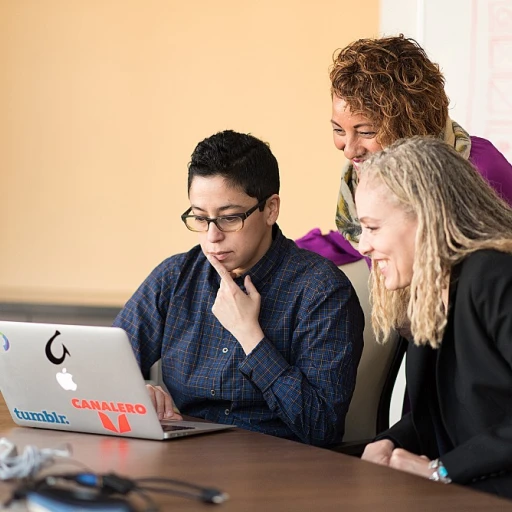Understanding the Basics of Mentoring
The Essence of Mentoring
Mentoring, much like a finely tuned instrument in an orchestra, plays a crucial role in harmonizing professional growth and personal development. At its core, mentoring is an enduring relationship between a mentor—an experienced and trusted advisor—and a mentee eager to learn and progress. The mentor provides guidance, support, and knowledge that help the mentee navigate the complexities of their professional landscape.
Understanding the nuances of mentoring is essential before delving into the various forms it can take. Each form, whether formal mentoring programs or the more casual approach of informal mentoring, brings its unique benefits and challenges to the table. They all, however, share a common goal: to foster growth and development in a professional setting.
In the world of mentoring, the collaboration is a two-way street. It is not just about imparting wisdom; it is about creating a dynamic and collaborative environment that encourages open communication, learning, and mutual respect. Reverse mentoring, for instance, offers a fascinating twist where younger or less experienced individuals provide fresh perspectives to seasoned professionals.
Mentoring takes many shapes, each offering different strategies to achieve professional enhancement. Understanding the foundational principles of mentoring prepares multiple avenues for further exploration, such as group mentoring or virtual mentoring. These variations offer unique methods and opportunities, as we will see in subsequent discussions.
What Constitutes a Structured Mentorship?
Formal mentoring programs are the cornerstone of many organizations aiming to foster talent development and career growth. These programs are meticulously designed, often with set objectives, timelines, and evaluation measures to ensure that both mentors and mentees benefit from the relationship. Formal mentorships usually start with a defined application process, allowing individuals to express their interest and goals. This matching process ensures that mentors are paired with mentees whose needs and expectations align with their expertise and experiences.
Once a mentorship pair is formed, they embark on a journey guided by a well-structured framework. Regular meetings are scheduled to ensure sustained engagement, and specific milestones are established to track progress. These programs often incorporate mentorship training sessions to equip mentors with the necessary tools and techniques to be effective in their roles. Analyzing outcomes is a critical phase of formal mentoring, as organizations seek to measure the impact of the mentorship on personal development and organizational success.
This structured approach not only provides clarity and direction but also creates a standardized method of feedback and reporting, which is crucial in assessing the efficacy of these programs. While formal mentoring offers many benefits, it exists alongside other methods, such as informal mentoring, which thrives on personal initiative and mutual interests rather than organizational oversight.
The Subtle Dynamics of Unscripted Mentoring
In the ever-evolving landscape of professional development, there lies a realm of mentoring that flows naturally and organically—informal mentoring. While structured programs are powerful conduits of growth, the informal process often occurs with a gentle spontaneity, fostered by everyday interactions rather than formal commitments.
In workplaces across the globe, leaders and newcomers often find themselves engaging in unplanned yet impactful mentorship relationships. These interactions may take place over a cup of coffee or arise through engaging in collaborative projects. Unlike their formal counterparts, informal mentorships are not bounded by rigid frameworks or schedules, but are rooted in mutual respect, shared interests, and a common goal of personal and professional growth.
This type of mentoring is a testament to the natural human inclination to learn from those with different experiences and insights. With informal mentoring, the wisdom shared is often accompanied by a sense of authenticity and genuine concern for one another’s advancement. It provides an opportunity for mentees to gain valuable insights from mentors who might not have been paired with them in more structured settings, thereby broadening their perspectives and enriching their career trajectories.
The growing popularity of reverse mentoring, as we see in other forms of mentoring, adds another layer of richness to these interactions. Such dynamics foster an environment where sharing knowledge and experiences doesn't depend solely on rank or seniority.
As we further explore the multifaceted nature of mentoring, it is crucial to acknowledge the unique value that informal mentoring offers. It complements formal programs beautifully, making them holistic, inclusive, and enabling a culture of continuous learning.
To explore more about how different mentoring programs can unlock professional growth, visit
this article on workplace mentoring programs. Together, formal and informal pathways create a vibrant tapestry of mentorship that can powerfully impact individual careers and organizational success.
The Rise of Reverse Mentoring
Reimagining Leadership Dynamics with Reverse Mentoring
In today’s ever-evolving professional landscape, the relationship between mentor and mentee is constantly being redefined. One intriguing trend challenging traditional paradigms is reverse mentoring. Originally coined as a concept to encourage the transfer of skills and knowledge from younger employees to more seasoned professionals, reverse mentoring can profoundly reshape organizational structures and personal growth alike.
At its core, reverse mentoring emphasizes the value of fresh perspectives that younger generations bring to the table. These individuals are often more attuned to the latest digital trends, technological innovations, and new-age communication tools that can revolutionize existing workflows and methodologies. As these mentees guide their mentors through the digital terrain, they simultaneously foster an environment of mutual learning and respect.
This shift not only democratizes the flow of knowledge but also signals a move toward more collaborative workplace cultures. In this mutual exchange, experienced employees can better understand the motivations and challenges facing younger workers, enriching intergenerational dialogue and enhancing team dynamics. The potential of reverse mentoring lies in breaking down hierarchical barriers, making organizations more agile and adaptable.
While diving into the intricacies of reverse mentoring, it’s important to recognize that it complements other types of mentoring seamlessly. Just as formal mentoring programs provide structured learning, and informal mentoring creates organic relationships, reverse mentoring serves as a reciprocal enabler for professional growth across age groups. As companies continue to embrace this novel approach, they forge paths for sustained innovation and shared empowerment, ultimately redefining what mentorship can achieve.
Group Mentoring: Strength in Numbers
Leveraging Mentoring for Group Dynamics
In an era where collaboration is increasingly emphasized, group mentoring has emerged as a powerful and effective approach to professional development. Unlike traditional one-on-one mentoring, group mentoring involves a mentor working with a small group of mentees, cultivating a shared learning environment that offers collective wisdom and diverse perspectives.
One of the standout advantages of group mentoring is its ability to foster inclusivity and broaden horizons. Each participant brings a unique set of skills, experiences, and viewpoints to the table, creating a rich tapestry of ideas for everyone to tap into. This dynamic not only enriches the learning experience, but it also presents opportunities for mentees to learn from each other's successes and challenges, thereby accelerating their professional growth.
The structured setting of group mentoring also encourages a culture of peer learning. Participants are often motivated to contribute actively to discussions, sharing insights and feedback that can deepen understanding for all involved. As a result, mentees can develop stronger problem-solving abilities while enhancing their communication and leadership skills.
While it shares some similarities with formal mentoring programs, group mentoring's collaborative nature makes it distinct. It requires careful coordination to ensure all voices are heard and valued. This necessitates the mentor adopting facilitative skills to guide the conversation productively and maintain a supportive atmosphere.
Furthermore, group mentoring can serve as an excellent complement to other mentoring types, such as informal or virtual mentoring. It can enhance individual mentoring experiences by offering additional viewpoints and support networks.
Incorporating group mentoring into an organization's professional development strategy can yield significant benefits. By promoting a learning culture that values diversity and collective growth, companies can build resilient teams that are better equipped to tackle challenges and innovate. Ultimately, embracing the strength in numbers offered by group mentoring can transform both personal and organizational success.
Virtual Mentoring in the Digital Age
The Advantages of Digital Guidance
In today's interconnected world, virtual mentoring has emerged as a crucial aspect of professional development. As seen in previous sections, traditional mentoring relationships often rely on face-to-face interactions, but the digital age challenges us to rethink how these connections are formed and maintained.
Virtual mentoring offers a valuable alternative that transcends geographical boundaries. No longer confined to the limitations of physical proximity, mentees can connect with mentors from across the globe, allowing for a diverse exchange of ideas and experiences. This worldwide reach is especially beneficial in industries where specific expertise or niche knowledge might be scarce in one's locality.
Moreover, virtual mentoring affords flexibility that cannot be matched by traditional methods. Busy professionals can schedule meetings at times that suit their convenience, eliminating the need to coordinate physical travel or compromise on in-person availability. This flexibility can lead to more frequent and consistent interactions, ultimately fostering a stronger mentoring relationship.
Embracing technology in mentoring also opens doors to innovative communication tools and platforms. Whether through video conferencing, instant messaging, or collaborative online environments, mentors and mentees can share resources, track progress, and set goals efficiently. This technological integration not only enhances communication but also creates a dynamic environment for learning and feedback.
While virtual mentoring offers numerous advantages, it's essential to be mindful of the potential challenges that come with remote interactions. Building trust and establishing a strong rapport can be more challenging without the nuances of face-to-face contact. As such, effective communication strategies and a commitment to fostering an open, honest relationship remain vital components of successful virtual mentoring.
As we navigate the complexities of the digital age, virtual mentoring presents a promising frontier for professional development. Its adaptability and wide-reaching capabilities make it an essential tool for modern professionals looking to harness the full potential of their careers.








